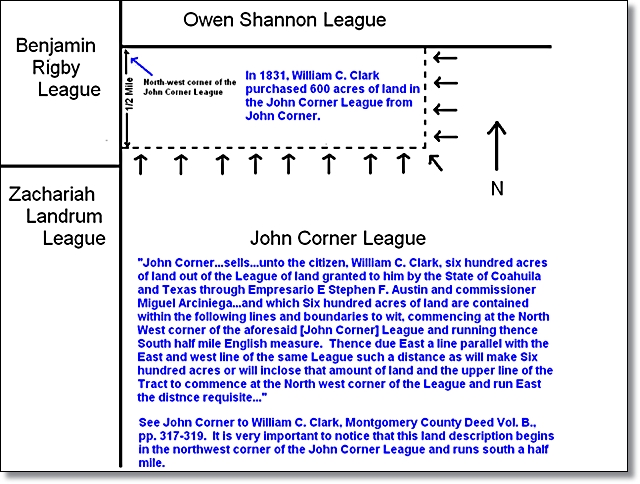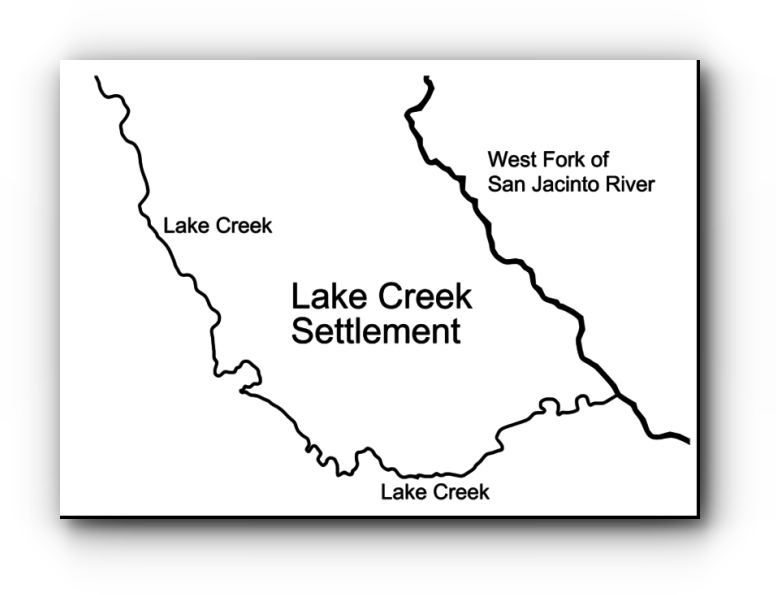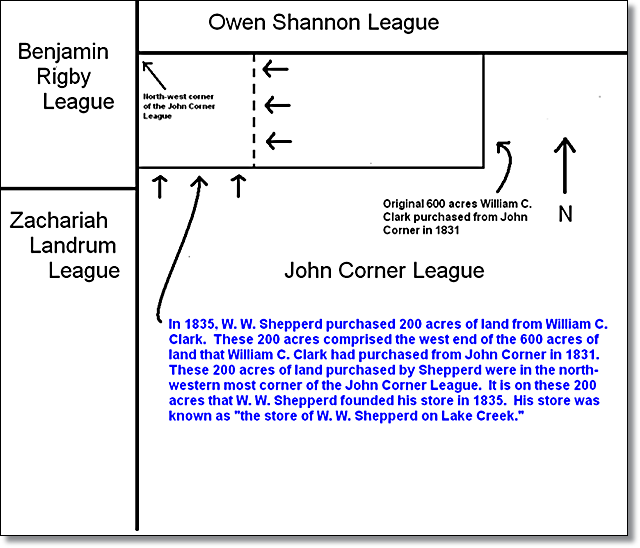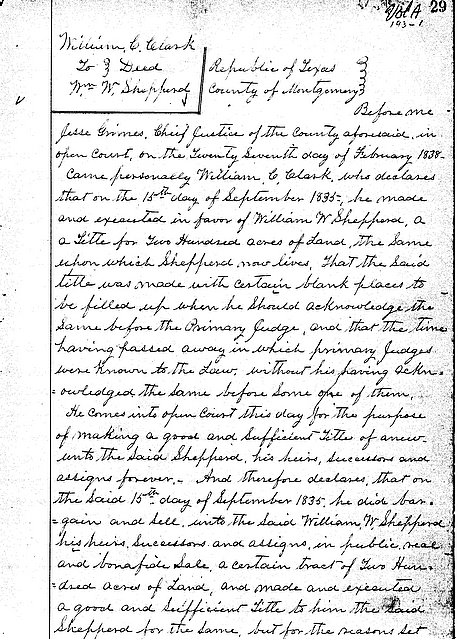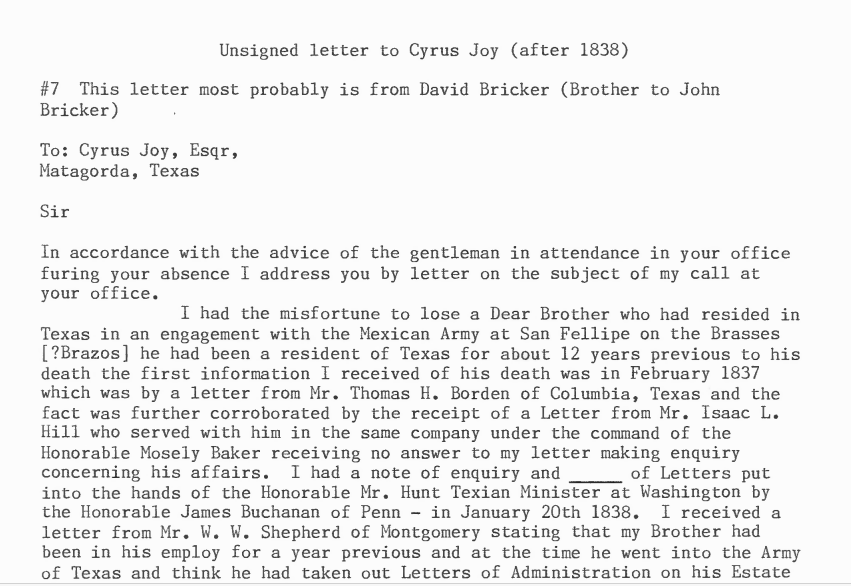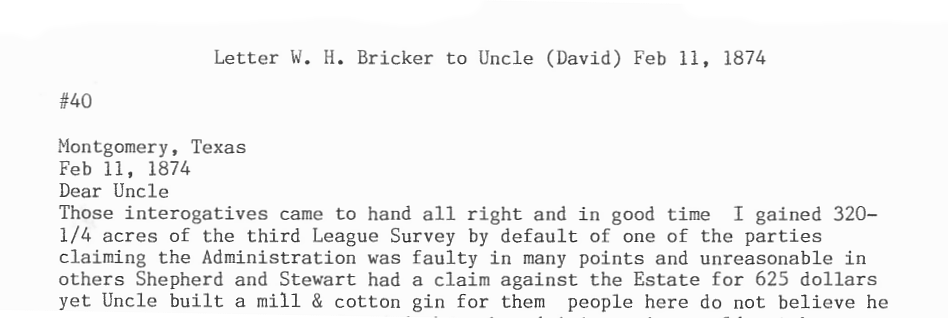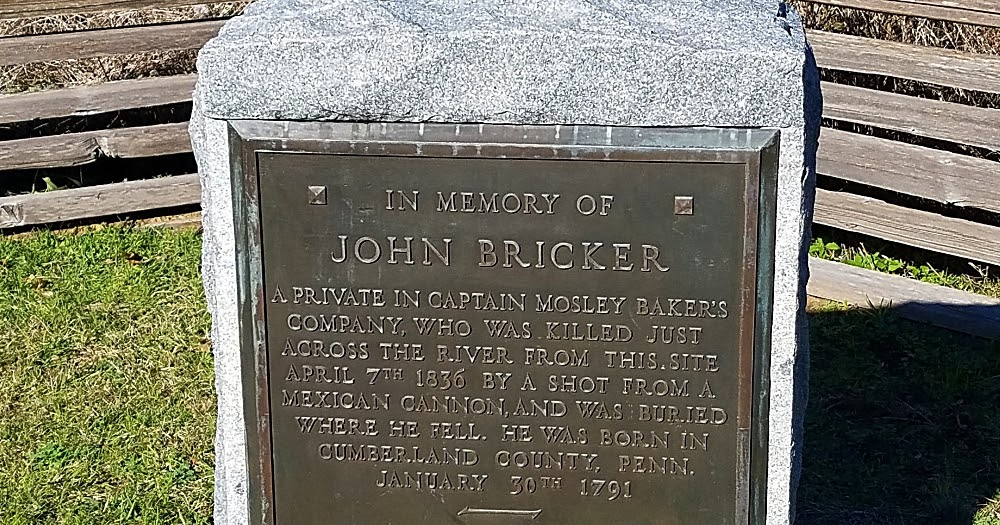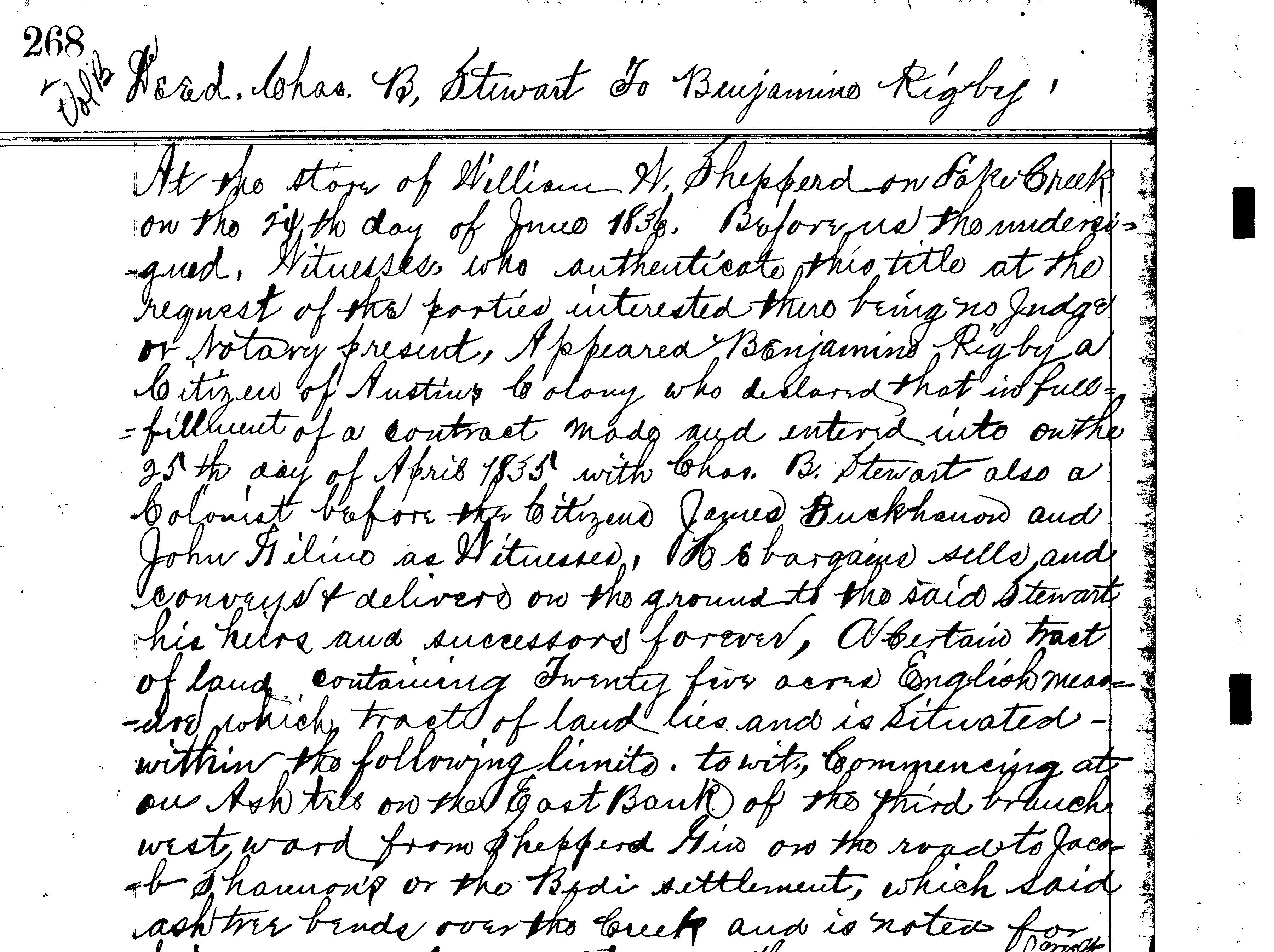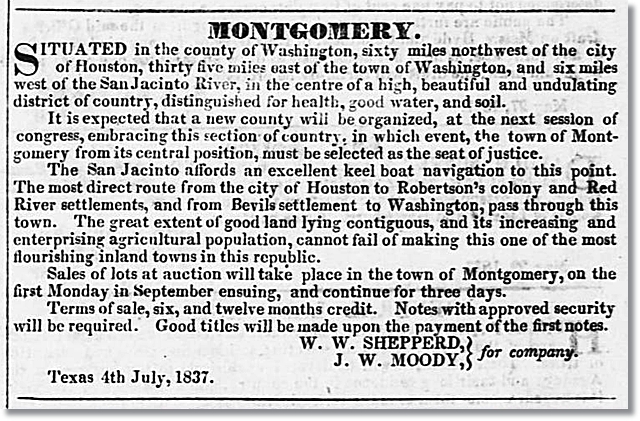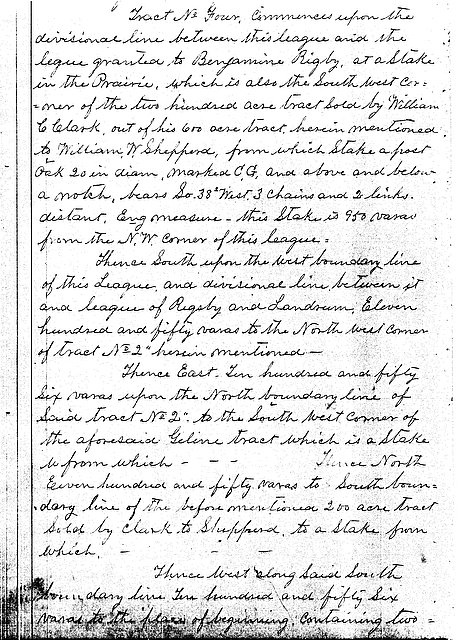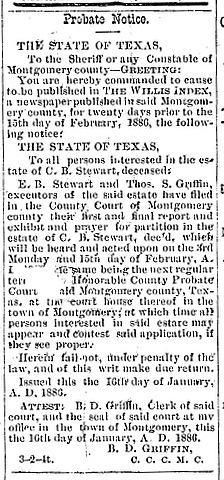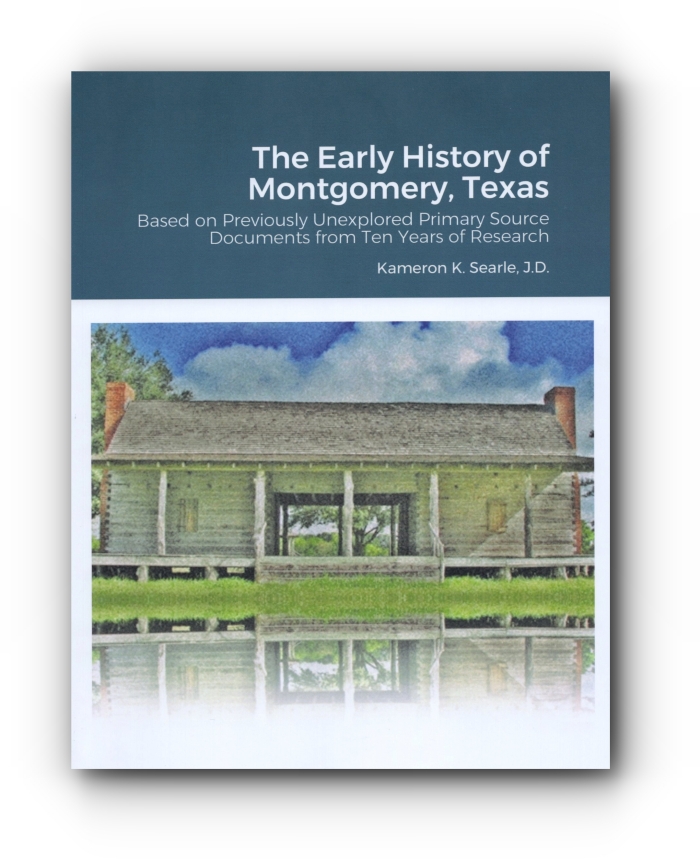
History of the Indian Trading PostandThe Founding of the Town of Montgomeryin July, 1837(From: The Early History of Montgomery County, Texas)by: Kameron Searle Artistic Rendering of How W. W. Shepperd's Store/Indian Trading Post May Have Appeared in 1835 Courtesy of Marisa Searle
"There were at that time a few of the descendants of the original settlers of this county who came with their parents to this section as colonists, but were altogether ignorant of the organization of the old 'principality' of Montgomery...W. W. Shepperd was the first to have a store at the old town of Montgomery under the hill...I am enclosing to you for your inspection the original draft of the flag of the Republic of Texas. The work was without question the work of my father..."
The Indian Trading Post that Became the Town of Montgomery, Texas This is the history of the Indian trading post founded in the Lake Creek Settlement that preceded the town of Montgomery, Texas. This article also includes many details regarding the origin of the so-called "old town of Montgomery under the hill" and the so called "new town" of Montgomery on top of the hill.
First Settlers Received Mexican Land Grants - 1831 The first settlers, in what would later become western Montgomery County, received their Mexican land grants in 1831. The settlers who received land grants in this area included Archibald Hodge (April 3, 1831), Mary Corner (April 7, 1831), John Pevehouse (April 7, 1831), James Hodge (April 8, 1831), Owen Shannon (April 8, 1831), William C. Clark (April 10, 1831), William Landrum (April 10, 1831), Zachariah Landrum (April 10, 1831), William M. Rankin (April 10, 1831), Noah Griffith (April 11, 1831), Benjamin Rigby (April 14, 1831), William Atkins (April 18, 1831), Jacob Shannon (April 30, 1831), Raleigh Rogers (May 6, 1831), John Corner (May 10, 1831), Anna White (May 12, 1831), Thomas Corner (May 28, 1831), and John Cronkrite (June 21, 1831). These settlers received their Leagues of land from Empresario Stephen F. Austin. These Mexican land grants were located in Austin’s Second Colony.
John Corner's Mexican Land Grant - May 10, 1831
See Texas General Land Office, County: Montgomery, Abstract Number 8, District/Class: Title, File Number: SC 000011:1, Original Grantee: John Corner, Title Date: 10 May 1831, Patent Number: 1358, Patent Vol: 5, Acres: 4428.4.
Texas State Library and Archives - English Field Notes 6-423 1831 Plat Drawn by Surveyor Elias R. Wightman of the John Corner League On May 10, 1831, John Corner received title to a League of land from Empresario Stephen F. Austin. The John Corner League is very important to our study. The trading post will be established on the John Corner League in 1835 and the Town of Montgomery will be founded on the John Corner League in July of 1837.
William C. Clark Purchased 600 Acres from John Corner - January 1, 1831
Image by Kameron Searle On January 1, 1831, William C. Clark purchased six hundred acres of land in the John Corner League from John Corner. Below is a copy of the deed from John Corner to William C. Clark as later recorded in the Montgomery County Clerk's Office. Deed John Corner to William C. Clark, Montgomery County Deed Vol. B. p. 317
See John Corner to William C. Clark, Montgomery County Clerk, Deed Vol. B. pp. 317-319. It is very important to notice that this land description begins in the northwest corner of the John Corner League and runs south a half mile. Image by Kameron K. Searle William C. Clark paid John Corner $250.00 on January 1, 1831 for these six hundred acres of the John Corner League before John Corner actually received the title to it. Given the fact that this purchase pre-dated Corner's receipt of his land grant, it appears that William C. Clark helped to pay John Corner's costs and fees to clear his title out of Stephen F. Austin's land office at San Felipe.
John Corner Received Mexican Land Grant - May 10, 1831 On May 10, 1831, John Corner finally received his Mexican land grant for one League of land [League No. 27] from Empresario Stephen F. Austin in Austin’s Second Colony. As shown above, John Corner had already sold six hundred acres of land out of the John Corner League to William C. Clark on January 1, 1831. See Deed - Government to John Corner, Montgomery County Deed Vol. A, pp. 32-35. Also see, Deed - John Corner to William C. Clark, Montgomery County Deed Vol. B. pp. 317-319. See partial transcription of this deed above.
Lake Creek Settlement Soon after the first settlers arrived, the lands between the West Fork of the San Jacinto River and the stream called Lake Creek became known as the Lake Creek Settlement. The area was also commonly referred to as the District of Lake Creek, Precinct of Lake Creek or simply Lake Creek.
For an early example of a document using the term Lake Creek Settlement, see 1833 Articles of Agreement, Jacob Shannon to Rutha Miller, Montgomery County Deeds, Vol. N, page 254. Click here for more information about the Lake Creek Settlement. The Lake Creek Settlement article currently lists more than 70 different primary documents (with digital scans) proving the existence of the place known as Lake Creek Settlement, Lake Creek District, Precinct of Lake Creek and Lake Creek.
W. W. Shepperd Purchased 200 Acres from William C. Clark - September 15, 1835 Image by Kameron K. Searle On September 15, 1835, William W. Shepperd (hereinafter W. W. Shepperd) purchased two hundred acres of land from William C. Clark in the northwestern most corner of the John Corner League. These were the two hundred western most acres of the six hundred acres that William C. Clark purchased from John Corner on January 1, 1831. See Deed from William C. Clark to Wm. W. Shepperd, Montgomery County Deed Vol. A, pp. 29-32. Deed William C. Clark to Wm. W. Shepperd, Montgomery County Deed Vol. A. p. 29
It is here in the middle of the Lake Creek Settlement on the two hundred northwestern most acres of the John Corner League that W. W. Shepperd will found the first trading post. Here, he will trade with the Indians and the early settlers. Known as “the store of W. W. Shepperd on Lake Creek,” this is the Indian trading post that preceded the town of Montgomery. And it is exactly where the early historians said it was supposed to be – about a half mile north of the town under the hill on the creek that would later be known as Town Creek. See the numerous deeds and other records executed at “the store of W. W. Shepperd on Lake Creek" at the Lake Creek Settlement link on the TexasHistoryPage.com. The store was close to the creek that would later be known as Town Creek. Town Creek then as now was a tributary of Atkins Creek. The creek would not be called "Town Creek" until some time after Shepperd founded the town of Montgomery. Important Note: Documents executed at the trading post described the place as "the store of W. W. Shepperd on Lake Creek". "On Lake Creek" does not actually describe the creek that Shepperd's trading post or store was located next to. The descriptor "on Lake Creek" refers an area drained by Lake Creek or on the waters of Lake Creek. Some Mexican land grants and early deeds refer to the area as being on the waters of the "San Jacinto River" and others refer to the lands in this area as being "on Lake Creek" and some as we will see shortly refer to it both ways. It was a common practice of the time to refer to lands drained by a particular river or creek as being "on that waterway." Since there were no towns and there were very few named places, named waterways were used to tell people where something was. People familiar with Lake Creek or the West Fork of the San Jacinto River had a much better understanding of where a location was if it was described as "on Lake Creek" or "on the San Jacinto River." Since the San Jacinto River is so long, the descriptor, "on Lake Creek" was a much more specific descriptor than "on the San Jacinto River." As an example, an early deed record, executed on June 30, 1831, refers to the Owen Shannon League (located just north of the John Corner Leagu) as being "on Lake Creek west of San Jacinto." See Owen Shannon to Thomas Taylor, Montgomery County Clerk, Deed Book B, page 282. This particular descriptor managed to work in both of the aforementioned waterways. Note, Lake Creek did not run through the John Corner League [where Shepperd's trading post/store was located], and neither Lake Creek nor the San Jacinto River ran through the Owen Shannon League. These waterway descriptors told people approximately where a place was located in vastness of Austin's Colony.
In what may very well be the earliest marriage for which there is a written record during the Republic of Texas, Texas founding father C. B. Stewart will marry Julia Shepperd, the daughter of W. W. Shepperd, on these two hundred acres of land at “the house of W. W. Shepperd on Lake Creek” on March 11, 1836 while serving as delegate to the Texas Independence Convention at Washington-on-the-Brazos. See Deed Book A-1, Washington County Clerk, pp. 240-243. And, the town of Montogmery will be founded on these two hundred acres in July of 1837.
Shepperd Gin In the year (1835-1836) prior his service in the Texas Revolution, John Bricker built a gin and a mill for W. W. Shepperd.
The Bricker Papers, Page 31
We find this transcription of a letter to Cyrus Joy (written after 1838) which reads in part, "I received a letter from Mr. W. W. Shepherd of Montgomery stating that my Brother [John Bricker] had been in his employ for a year previous and at the time he went into the Army of Texas." This letter is located in The Bricker Papers on page 31. The letter goes on to say that John Bricker lived with the Shepperds during the time he was working for them. Both of these documents are in the transcription of the MONTGOMERY COUNTY DISTRICT COURT, EXHIBIT BOOK OF LETTERS AND DOCUMENTS, V. 3 OF STATEMENT STATEMENT OF FACTS, (papers pertaining to the Bricker Family) THE BRICKER PAPERS. Click here to read the transcription of The Bricker Papers on the Montgomery County GenWeb website.
The Bricker Papers, Page 91
In The Bricker Papers, we find this transcription of a letter from W. H. Bricker dated February 11, 1871 which reads in part, "...Shepherd and Stewart had a claim against the Estate [John Bricker's Estate] for 625 dollars yet Uncle [John Bricker] built a mill & cotton gin for them..." This gin was located on the 200 acres Shepperd had purchased from William C. Clark in the John Corner League. The Shepperd Gin is mentioned in an early deed from Charles B. Stewart to Benjamin Rigby and dated June 24, 1836. The Shepperd Gin is used as a landmark in the metes and bounds description in the deed. The deed was executed "At the store of W. W. Shepperd on Lake Creek." Later, when the town of Montgomery "on the hill" is established following the creation of Montgomery County and the selection of Montgomery as the County seat, the original map (or plat) will also indicate W. W. Shepperd's gin located to the north on the original Montgomery town site "under the hill." John Bricker Marker at San Felipe de Austin State Historic Site
August 25, 1838 Edition of Telegraph and Texas Register Newspaper(Houston, Texas), Page 4
Deed Charles B. Stewart to Benjamin Rigby, Montgomery County Deed Vol. B. p. 268
The metes and bounds land description reads in part, "...an Ash tree on the East Bank of the third branch [of the creek known as Town Creek today] westward from Shepperd Gin on the road to Jacob Shannon's or Bedi settlement..." .Shepperd Gin
Town of Montgomery Founded - July 8, 1837 "Old Montgomery" or the "Old Town Below the Hill" Saturday, July 8, 1837, Telegraph and Texas Register Newspaper (Houston, Texas), Vol. 2, No. 25, p. 3
On July 8, 1837, names “Montgomery” and the “town of Montgomery” appeared in print for the first time in the Telegraph and Texas Register newspaper. The town of Montgomery was founded in Washington County by W. W. Shepperd in association with J. W. Moody. J. W. Moody was the First Auditor of the Republic of Texas. The town is founded on the 200 acres of land W. W. Shepperd purchased from William C. Clark on September 15, 1835. Shepperd had previously founded his trading post or store here. Later historians will refer to this town as “the old town under the hill” or “old Montgomery.” W. W. Shepperd and his wife Mary Steptoe Shepperd, lived there in a house with their minor children. There adult children also lived there. By July 1837, Charles B. Stewart was living there as well. The blacksmith was named Thomas Adams and he had built a house. W. W. Shepperd owned a number of slaves. His wife, Mary Steptoe Shepperd, owned at least eight slaves that she had inherited from her father. Of course all of these slaves would have lived in houses there as well. Following the July 8, 1837 advertisement in the Telegraph and Texas Register newspaper, W. W. Shepperd would begin selling lots on these 200 acres. As an example, Charles Garrett, the son in law of Owen Shannon and Margaret Montgomery Shannon, purchased a lot from Shepperd here in 1837. See Deed of William W. Shepperd to Charles Garrett, Montgomery County Deed Vol. B, p. 304.
W. W. Shepperd and his associate, J. W. Moody, named the town "Montgomery" after Montgomery County, Alabama where J. W. Moody had been the Clerk of the County Court of Montgomery County, Alabama, for many years before coming to Texas. Montgomery County, Alabama was named for Lemuel Montgomery who was killed in the Battle of Horseshoe Bend.
Montgomery County Created - December 14, 1837 Five months after the Town of Montgomery was founded the Congress of the Republic of Texas creates Montgomery County out of the territory of Washington County. President Sam Houston signed this act into law on December 14, 1837. The county is named after the town. AN ACT Creating the county of Montgomery
The Act creating the County of Montgomery on December 14, 1837 included the following language providing for the appointment of nine commissioners to search for a suitable seat of justice:
See Laws of the Republic of Texas, In Two Volumes, Printed by Order of the Secretary of State, Volume II, Houston, Printed at the Office of The Telegraph, 1838, p. 33. Though no document has been discovered to show when these nine commissioners actually selected the town of Montgomery to be the seat of justice, it is obvious that they did so quickly.
The "Old Town" of Montgomery Was First County Seat A number of deed records and court records prove that the "old town" of Montgomery "under the hill" was the first seat of justice or county seat of Montgomery County. This was the original town of Montgomery founded by W. W. Shepperd in July of 1837 on the 200 acres of land that Shepperd purchased from William C. Clark on September 15, 1835.
Montgomery County Clerk, Deed Book A, p. 15 From Mary Corner to Julia T. Stewart, Montgomery County Deed Book A, pp. 11-15
This deed and other primary records prove that the county seat of Montgomery County was already located in the Town of Montgomery (the so-called "old town of Montgomery under the hill") by February 26, 1838. Vol. A, p. 20 From Government to Mary Corner, Montgomery County Deed Book A, pp. 16-20
Montgomery County Chief Justice, Jesse Grimes, and Montgomery County Clerk and Recorder, Gwynn Morrison, were conducting business in the "old town" of Montgomery as early as January 31, 1838. As an example, see John M. Springer to Jeremiah Worsham, Montgomery County Deed Vol. A, pp. 3 and 4. This deed was recorded on January 31, 1838 - a full month before the first Montgomery County Commissioners Court meeting. Deed Book. A, p. 38-39 From William C. Clark to John Corner, Montgomery County Deed Book A, pp. 36-39
Chief Justice Jesse Grimes was very clear in this document as to his exact location and his acitivies on behalf of Montgomery County. He was acting in his "...official capacity as Chief Justice and Ex Officio Notary Public in and for the County of Montgomery, Republic of Texas, In open Court, on the 28th day of February 1838... in the Town of Montgomery." Court was being held in the town of Montgomery on February 28, 1838. W. W. Shepperd had only purchased the 212 acre Tract No. 4 from John Coner on February 26, 1838 and he would not donate a one half undivided interest in Tract No. 4 to Montgomery County until the next day on March 1, 1838. The County Commissioners Court would not move the place of the town until March 1, 1838, so Jesse Grimes was conducting county business in the old town of Montgomery under the hill on February 28, 1838. W. W. Shepperd did not have to give the county the half undivided interest in the town of Montgomery to the county to induce the Commissioners to locate the county seat in the Town of Montgomery. The county seat was already in the the old town of Montgomery under the hill before the first Montgomery County Commissioners' Court meeting on March 1, 1838. As I locate deeds and other county records that have earlier dates, I will include them here to try and pinpoint the earliest date Montgomery County began to conduct business. I believe I have seen a document dated in December just days after the county was created on December 14, 1837.
W. W. Shepperd Purchased 200 Acres from John Corner - February 26, 1838 On February 26, 1838, just three days before the first Montgomery County Commissioners Court meeting on March 1, 1838, W. W. Shepperd purchases four tracts of land containing 2,426 acres from John Corner on the John Corner League. One of these tracts was Tract No. 4 which contained 212 acres of land. These 212 acres of land are located immediately south of the two hundred acres Shepperd had purchased from William C. Clark on September 15, 1835. Deed John Corner to Wm. W. Shepperd, Montgomery County Deed Vol. A. p. 21
See John Corner to Wm. W. Shepperd, Montgomery County Deed, Volume A, pp. 21-28. The tract described as Tract No. 4 in this deed is important. On March 1, 1838, W. W. Shepperd will donate an equal half undivided interest in 200 of these 212 acres of land to Montgomery County. Tract No. 4 will later be known in future deeds and documents as the “Town Tract” or the “Montgomery Town Tract.”
W. W. Shepperd Makes Donation to Montgomery County - March 1, 1838 "New Town" of Montgomery At the first meeting of the Montgomery County Commissioners Court on March 1, 1838, W. W. Shepperd, through his agent, C. B. Stewart, donated an equal half undivided interest in the Town of Montgomery (200 acres) and sixty acres of pine land adjoining the town to the county. "[I]t being put to question whether said donation should be accepted it was unanimously received - and the question being also whether the place of the Town presented by C. B. Stewart as agent for W. W. Shepperd should be received the same was also unanimously received and adopted.” Below are the original minutes of the first Montgomery county Commissioners Court meeting and the deed record of Shepperd's Donation to Montgomery County. Minutes of First Montgomery County Commissioners Court Meeting March 1, 1838 Page 1
Below is a copy of W. W. Shepperd's land donation of one equal undivided half interest in the Town of Montgomery to Montgomery County on March 1, 1838. See Montgomery County Clerk, Deed Vol. E, p. 285
Accepted Donation Montgomery From W. W. Shepperd Accepted Donation Montgomery From W. W. Shepperd
The site selected by the Montgomery County Commissioners Court on March 1, 1838 as the location of the county seat is the same land purchased by W. W. Shepperd from John Corner three days before on February 26, 1838. Later, historians will describe this as “the new" town of Montgomery to differentiate it from the "old town" of Montgomery under the hill. Image by Kameron Searle It is important to note that the first Montgomery County Commissioners Court meeting was actually held in the "old town" of Montgomery. The original courthouse was a house that belonged to W. W. Shepperd which was located in the "old town" of Montgomery. It would also appear the original county courthouse remained in the "old town" of Montogmery for a period of time until it was moved up to the "new town" of Montgomery.
Edmund B. Stewart Letter to Mrs. J. W. Brosig - July 7, 1922 On July 7, 1922, Edmund B. Stewart of Montgomery, Texas, wrote a letter to Mrs. J. W. Brosig of Navasota, Texas. Historians in the town of Montgomery and in Montgomery County have cited this letter for decades to prove the provenance (history of ownership) and authenticity of Charles Bellinger Stewart’s original drawing of the Lone Star flag of Texas. Edmund B. Stewart was the son of Charles B. Stewart and his second wife, Elizabeth Antoinette Boyd. This letter originally appeared in an article, “Original Flag of Texas Shown Here Tomorrow,” in the August 11, 1922, Daily Examiner newspaper in Navasota, Texas. This July 7, 1922 letter was the letter in which Edmund B. Stewart transferred the original drawing of the Lone Star flag drawn by Charles B. Stewart to Mrs. Brosig to display in her hardware store in Navasota. Edmund B. Stewart wrote,
See the Dr. Charles Bellinger Stewart Family Papers, Houston Metropolitan Research Center, [Texas Room, Julia Ideson Building, Houston Public Library, Houston, Texas. The Anna Landrum Davis history essay, Old Montgomery, was written in 1925. The Edmund B. Stewart letter to Mrs. J. W. Brosig pre-dates the Anna Landrum Davis history paper by three years making his letter the earliest account. It is the family history of a member of the C. B. Stewart household. There were only three men that had an active role in the founding of the trading post and the town of Montgomery: W. W. Shepperd, J. W. Moody and C. B. Stewart. C. B. Stewart had been married to his first wife, Julia Shepperd on the land that became the origianl site of the town of Montgomery under the hill. Stewart had owned land in the original town of Montgomery under the hill. Julia Shepperd, Stewart's first wife, was the daughter of William W. Shepperd who Founded the original town of Montgomery under the hill. C. B. Stewart helped locate the site of the town of Montgomery at the new site on the hill on March 1, 1838. Edmund B. Stewart grew up listening to his father, C. B. Stewart who was an eye-witness to the events surrounding the founding of the town of Montgomery. Though this family history is a secondary source, it is reliable in that it is the family history of a member of the household of one of those intimate with the actual details of the earlier trading post and the founding of the town. C. B. Stewart was married on the two hundred acres where the trading post was located. Stewart was the son-in-law of W. W. Shepperd. C. B. Stewart's dry goods were sold at the store of W. W. Shepperd on Lake Creek. Stewart and his wife Julia Shepperd owned land and lived in the “old town” of Montgomery. C. B. Stewart acted as W. W. Shepperd's agent at the first Montgomery County Commissioners Court meeting on March 1, 1838 when the "new town" of Montgomery was selected as the county seat. Edmund B. Stewart's letter is also well corroborated by a large number of primary historical documents. Edmund B. Stewart was born June 26, 1852. E. B. Stewart was the son of Charles Bellinger Stewart and his second wife, Elizabeth Antoinette Boyd. When his father died in 1885, E. B. Stewart was 33. E. B. Stewart would also be the executor of his father's estate. The Willis Index January 29, 1886 - Probate Notice
See The Willis Index, Friday, January 29, 1886, Vol. III - No. 3, p. 2, "Mary Davis Collection", Albert and Ethel Herzstein Library, San Jacinto Museum of History. At the time E. B. Stewart wrote his letter to Mrs. J. W. Brosig, he was 70 years old. E. B. Stewart died on March 31, 1925. Later that year, Anna Landrum Davis will enter her essay Old Montgomery and the Montgomery Trading Post myth will begin. For birth and death dates, see Early Settlers of Montgomery County, Montgomery Genealogical and Historical Society, Conroe, 1991, p. 66, "Application of Virginia Stewart (Lindley) Ford" pp. 52-67.
Map Showing the Northwest Corner of the John Corner League
On the map above, Town Creek is north of the present town of Montgomery. Town Creek is on the John Corner League, not the Owen Shannon League. William C. Clark purchased these 200 northwestern-most acres from John Corner in 1831 (as part of the 600 acre purchase). W. W. Shepperd purchased these 200 acres from William C. Clark on September 15, 1835. Shepperd would establish the Indian trading post/store on these 200 acres. In July of 1837, Shepperd would found the "old town" of Montgomery on these 200 acres in the northwestern-most corner of the John Corner League. Where many Montgomery County historians seem to have made their mistake is in assuming that the two hundred acres of land the present town of Montgomery was founded on was the northwestern most corner of the John Corner League. Under this assumption, the land north of town would be the Owen Shannon League. But, as we have seen, this is not the case. The two hundred acres due north of the “Montgomery Town Tract” are on the John Corner League.It is extremely important to note here that Town Creek is located on the John Corner League and not on the Owen Shannon League. See map above. It is another detail repeated in almost every version of the Montgomery Trading Post myth that is completely wrong. See Montgomery County map 83 by Hodge Mason Maps, Inc. in the Montgomery County Appraisal District Office in Conroe, Texas. This map shows the City of Montgomery as well as the boundary lines of the John Corner League and the Owen Shannon League. Also see map 86 which shows that Town Creek is not on the Owen Shannon League for its entire length. To obtain you own copies of these maps, contact Hodge Mason Maps,Inc.
W. W. Shepperd Sells "Old Town" and "New Town" of Montgomery to James McCown October 21, 1839 [Scan of Deeds and Bonds Coming]
Gutav Dresel Buys Whiskey from W. W. Shepperd In his journal, Gustav Dresel a German traveler who visited Montgomery County and the town of Montgomery mentions making a purchase from W. W. Shepperd in Montgomery on Christamas Eve in 1839.
See page 90, "A Yuletide Excursion," Gustav Dresel's Houston Journal, Adventures in North America and Texas, 1837-1841, Translated by Max Freund, Austin, University of Texas Press,1954. Conclusion W. W. Shepperd founded the Indian trading post or store on the 200 acres of land he purchased from William C. Clark on September 15, 1835. William C. Clark had purchased these 200 hundred acres as part of his 600 acre purchase from John Corner on January 1, 1831. W. W. Shepperd founded the trading post in the middle of the Lake Creek Settlement in 1835 When Shepperd created the town of Montgomery in July of 1837, the town of Montgomery was located on the same 200 acres he bought from William C. Clark on Septemeber 15, 1835. This will be referred to by later historians as the "old town", "old Montgomery'', "the old town below the hill" and "the old town under the hill." It is important to note that Montgomery County officials such as Chief Justice, Jesse Grimes, and Montgomery County Clerk and Recorder, Gwyn Morrison, had already been conducting county business in the "old town" of Montgomery located on the 200 acres that Shepperd had purchased from Clark in 1835. They had been doing so for several days before the first Montgomery County Commissioners Court meeting. Note: No one named Jacob Shannon, Owen Shannon, Margaret Montgomery Shannon, William Montgomery or Andrew Montgomery had anything to do with the founding of the trading post, the "old town of Montgomery" or the “new town of Montgomery.” W. W. Shepperd founded the trading post (1835), the "old town" of Montgomery (1837) and the "new town" of Montogmery (1838). Where Many of the Historians Made Their Mistake
As we surveyed the primary documents, we saw where many previous historians made a huge mistake. They assumed the 200 acres of land that the "new town" of Montgomery was founded on March 1, 1838 was in the northwestern-most corner of the John Corner League. That would make the lands "below the hill" part of the Owen Shannon League. This is not true. The Indian trading post and the "old town" of Montgomery were founded on the two hundred acres of land on the John Corner League due north of the present town of Montgomery. These two hundred acres were the two hundred northwestern-most acres of the John Corner League. It is also important to remember that Town Creek, which is almost always reported as the location of the Indian trading post by other historians, is in fact located on the John Corner League not the Owen Shannon League. Read and/or print a free copy of Kameron Searle's 56 page book The Early History of Montgomery, Texas - First Edition by clicking the image above OR to order the 56 page softbound 2nd Printing by sending $6.00 plus $3.00 postage and handling (check or money order) to Kameron Searle, 9111 Katy Fwy, Suite 202, Houston, Texas 77024. It is an essential tool for students and historians researching the early history of Montgomery County, Texas and for genealogists researching family and ancestors who lived in the Lake Creek Settlement prior to the founding of the Town of Montgomery, Texas in 1837. Hundreds of copies of the free PDF have been downloaded already. Get your free copy today. Discover, Understand, and Preserve.
See the Lake Creek Settlement entry on the Handbook of Texas Online written by Kameron Searle
1. Letter from Edmund B. Stewart to Mrs. J. W. Brosig, Dr. Charles Bellinger Stewart Family Papers, MSS 150, Box 1, Folder 2, Texas Room, Houston Metropolitan Research Center, Houston Public Library, Houston, Texas.
Photograph of dogtrot house at the top of this page was taken by and made to look like a painting by Marisa A. Searle. All rights reserved. The actual dogtrot house that was photographed is located in San Felipe, Texas. A dogtrot house usually consisted of two log cabins separated by a dogtrot or breezeway under a single roof. |





